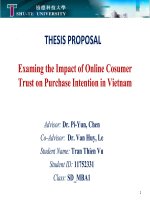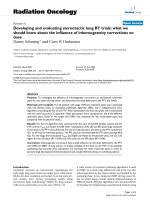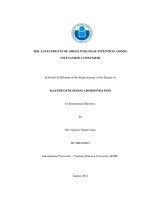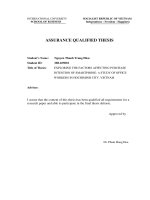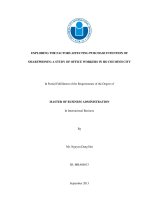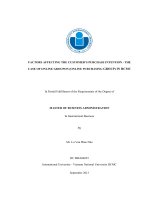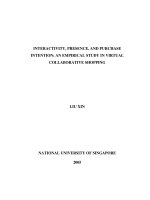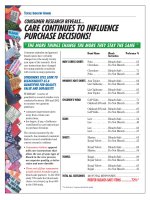Proposal SMA about factor influence purchase intention
Bạn đang xem bản rút gọn của tài liệu. Xem và tải ngay bản đầy đủ của tài liệu tại đây (230.71 KB, 20 trang )
LINK CANVA
Deadline tối 11h30 t5 23/10
“Factors influence the purchase intention of UEH university students for Samsung
smartphones “
1. Executive summary (1) Minh
Smartphones are now widely accepted as a necessary component of daily life, and the
majority of people always have one with them. (Li et al., 2021). In Q1 2022, the world
shipped 311.2 million smartphones, an 11% decrease from the previous quarter. After
updating its portfolio for 2022 and sending 73.7 million units, Samsung is still in the top 1.
(Canalys)
The purpose of this study is to investigate the impact of related factors, namely price, brand
image, and product features, on customers' purchase intention toward Samsung products.
The study aims to contribute to the existing literature by exploring the interrelationships
between these factors and their influence on consumer behavior. (Muljani, 2019).
A quantitative research method (Likert and multiple choice) will be used to collect data from
a sample of customers who have purchased or intend to purchase Samsung products. Price
(H1), brand image (H2), product features (H3), and social influences (H4) will be used as
independent variables, while purchase intention will be the dependent variable.
The research design will include a thorough review of academic and trade literature related
to the topic, along with the development of an analytical model to test the research
hypotheses. The data collection process will involve the use of structured questionnaires that
will be administered through online surveys.
The data analysis process will utilize statistical techniques such as correlation and
regression analysis to examine the relationships between the independent and dependent
variables. The results will be interpreted to identify the key factors that influence customers'
purchase intention toward Samsung products.
The findings of this study are expected to provide valuable insights for Samsung and other
companies in the electronics industry to develop effective marketing strategies. By
understanding the relative importance of price, brand image, and product features in shaping
customers' purchase intention, companies can better tailor their products and marketing
messages to meet the needs and preferences of their target customers.
1
In conclusion, this research will contribute to the existing literature on consumer behavior
and provide practical implications for businesses operating in the electronics industry. The
study is expected to provide a comprehensive analysis of the impact of related factors on
customers' purchase intention toward Samsung products and offers recommendations for
companies to improve their marketing efforts.
2. Background (1) Ly
Due to the increasing influence of technology in all aspects of daily life, technological
equipment is taking on more ergonomic shapes and sizes. Electronic accessories are highly
prevalent among people of all ages and educational levels. The advent of the smartphone
has dramatically benefited society (Zheng, Ni, 2006). Taking advantage of this trend, to
satisfy the enormous smartphone demand of the Vietnamese people, smartphones from
various companies have flourished across the nation. This will be the focus of the current
study.
Samsung, a Korean Native Company, has been very renowned for its smartphone business
and has made merchandise of millions of smartphones. Samsung has been quite well known
around the world and people sometimes compare them with the Smartphone predecessor
iPhone. On March 25, 2008, Samsung Electronics Vietnam was granted its first Investment
Registration Certificate (IRC) with a registered investment capital of 670 million USD.
Samsung had been selling millions, even billions of smartphones.
Despite its current reputation, it is still compulsory for Samsung to maintain its customer
purchase intention to compete in the market. Customers' purchasing intentions have been
found to be influenced by a number of variables, some of which include price, brand image,
and product features. Although several studies have made efforts to investigate the
relationship between these three factors and the purchase intention of customers toward
smartphones. The widespread use of smartphones in a developing country like Vietnam
suggests the necessity for empirical research about consumers' purchase intentions. This
study focuses on the precise observable variables that influence customers' purchase
intentions for iPhone products in Ho Chi Minh City, Vietnam, in order to meet those
demands. The study has examined and studied the smartphone market and the consumer
base to identify and explore the elements impacting purchase intention for Samsung
smartphones in this context. The body of research-related literature already in existence has
provided a chance to investigate the key variations among factors influencing purchase
intention for this particular product category and has demonstrated the effectiveness of the
2
study.
3. Objectives of the Research (1) Khoa
3.1 Explore and clarify the impact of related factors on the purchase intention of Samsung
products, which are price, brand image, product features, and social influences.
By conducting the literature review of the related framework, the research is able to explore
the main ideas of those, and how those can influence the purchase intention of GenZ
customers, in UEH university. Having a better understanding of the root cause, which
includes the factors, can enable Samsung to produce a suitable and realistic plan for future
products in Samsung’s smartphone category.
3.2
Analyse the difference between two groups of customers who purchase and do not purchase
Samsung smartphones by identifying the most significant independent variable
3.3
Provide recommendations on how to improve purchasing rates based on the findings of the
research.
4. Approach Khue
Literature review.
a. Purchase intention
Warshaw and David (1985) defined “purchasing intention” as planning to buy certain goods
or services in advance. It describes an individual's preference for product purchase and their
categorization of the available options (Zeithaml, 1988). Purchase intention represents a
consumer's willingness to purchase, that is if purchase intention is high the likelihood of
consumer willingness to purchase a product or service is also high (Schiffman and Kanuk,
2000).
b. Price
3
Price is the sum of money consumers is indebted to pay for products and services to fulfill
their needs or wants (Kotler, 2012). Some people think a product's value is better than the
amount paid but others may think it is just the opposite. Different people have different
perspectives and ideas about the value of money (Campbell, 1999). Hence, price deductions
may affect the customers' purchase decisions. Most of the time, customers have a higher
intention to purchase a product, if the discount rate is higher. There is also an opposite
picture, when the discount rate is lower, customers may have a lower intention to purchase a
product (Lay-Yee et al., 2013).
c. Brand image
Based on the definition from Kotler and Keller (2012), “Brand image” can be described and
understood as follows: “Once a sufficient level of brand awareness is created, marketers can
put more emphasis on crafting a brand image”. From the statement mentioned above, we
may understand that the brand image is something more valuable than the product. It means
that the brand can be used as a difference between one product with another similar
product, especially by using the brand image. Aaker (1996) defined the measurement of
brand image includes items, namely product attributes, consumer benefits, and brand
personality that can be described as follows:
Terms
Definition
Product Attributes
Which are matters relating to the brand itself
Consumer Benefits
What is the usefulness of the products of the brand
Brand Personality
As an association imagine a brand if the brand personality is
a human
d. Product features.
Nowadays, there are many high-technology features of smartphones in the market. Thus,
different people will choose different features of smartphones that can meet their needs and
desires. According to Oulasvirta et al. (2011), smartphones nowadays are featured with
wireless connectivity, a built-in web browser, application installation, full programmability, a
4
file management system, multimedia presentation and capture, high-resolution displays,
several gigabytes of storage and location as well as movement sensors. Based on previous
research, there are five design characteristics of mobile phones preferred by consumers
such as camera, color screen, voice-activated dialing, internet browsing, and wireless
connectivity (Ling et al., 2006). Based on study indicates that the respondents, mostly
college students, prefer to purchase smartphones due to their physical appearance, screen
size, and menu organization. Product features can be defined as the attributes of a product
that can satisfy consumers’ preferences through having the product and using it (Kotler &
Armstrong, 2020). According to Lay-Yee et al (2013), hardware is the surface of a device
that can be physically touched such as the body of the smartphone, size, weight, color as
well design. Meanwhile, the software includes computer programs, procedures, and
documentation. In addition, operating platforms, storage, or applications also can be
categorized as software. There are several types of operating software such as iOS,
Android, Windows... Hardware and software can be categorized as product features. Based
on previously done by Lay-Yee et al (2013), 31% of users prefer software compared to
hardware only 17.6%. This indicates consumers will look more at software rather than
hardware in purchasing the smartphone.
e. Social influences
Changing thoughts, feelings, attitudes, and behavior, intentionally or unintentionally, and
being influenced by other people in society is termed social influence (Rashotte, 2007).
Social influence affects the behavioral intention of customers (Lu et al., 2017) as it is
associated with the way other people influence one's beliefs, feelings, and behavior (Mason
et al., 2007) and people often adopt the thoughts, and feelings, attitudes, and behavior of
others (Chow et al., 2012). Surrounding people influence the action of consumers (Kotler et
al., 2010). It happens from the interaction among the various levels of people in society,
those who are known to each other like parents, family, peers, friends, relatives, and so on
(Rahim et al., 2016). When purchasing any product, family members can strongly influence
buyer behavior (Tikkanen, 2009). The young generation, especially students, is very much
dependent on suggestions from others when purchasing smartphones (Rahim et al., 2016).
Research Framework
5
Theory of planned behavior (TPB) is the foundation for studies relating to purchase
behavior, owing to its capability to predict a variety of behaviors and its fitness to explain
intentions. TPB
hypothesizes that behavior can be predicted by intention and that
people are prone to behave a particular way if they think that certain behaviors will
generate particular outcomes that align with values. TPB consists of constructs such as
attitude, subjective norms, and perceived behavioral control which guide human
behavior. Several previous studies have used the TPB as their theoretical framework
(Al-Swidi et al., 2014; Kumar & Smith, 2017; Shah Alam & Mohamed Sayuti, 2011)
Based on the above-mentioned reviews of literature, the researchers are now in a
position to propose a theoretical framework for this study. Based on the frameworks of
students’ demand for smartphones (Suki, 2013), generation Z consumers’ smartphone
purchase intention (Mohammed, 2018), and factors affecting young customers’
smartphone purchase intention during the Covid-19 pandemic (Rakib et al., 2022b), we
propose the framework of UEH university students Samsung smartphones purchase
intention. The conceptual framework dictates the effects of various independent
variables on the dependent variable. The proposed model tries to show the causal
relationship between the research variables in order to examine the impact of product
features, brand image, product price, and social influence on the purchase intention of
smartphones among the young generation consumers of UEH University.
Hypothesis
6
Clemes et al. (2014) found a positive impact of product variety on online purchase
intention
it concludes that there is a significant correlation between Product Feature Concern
with Customer Purchase Decision.
H1: Product features have a significant influence on young customers' purchase intention of
Samsung smartphones.
A reputed brand with a higher image enjoys major advantages compared to nonreputed
brands
as
it
is
associated
with
psychological
assurance.
A good or positive brand image is one that can have an added value impact on
consumers, if a brand has a bad image, it will indirectly affect consumers and most likely
consumers
are
not
interested
in
making
a
purchase.
A good brand image will be easily accepted by consumers, thereby increasing
customer satisfaction
=> H2: Brand image has a significant influence on young customers' purchase intention of
Samsung smartphones.
The price of the product tends to have a positive effect on the purchasing decision if
the price is rationally and commensurate with the benefit of the given product can influence
the
consumer
in
making
the
purchase.
The results cleared that product attributes including product information, quality, and
prices
had
positive
effects
on
purchase
intention.
Price sometimes serves as a signal of quality. A product priced “too low” might be
perceived as having low quality. Owning expensive items also provides information about
the owner. If nothing else, it indicates that the owner can afford the expensive item. This is a
desirable feature to some consumers.
=> H3: Product price has a significant influence on young customers' purchase intention of
Samsung smartphones.
The internet creates both positive and negative influences on customers purchasing
intention
through
social
media
communication.
Customers can learn and get available information about different brands from
various online media provided by other consumers sharing their own experiences and
opinions.
The social influence had a positive and significant influence, even though it was
7
weak towards the purchase intention of Starbucks Coffee as an environmentally friendly
product.
=> H4: Social influence has a significant influence on young customers' purchase intention
of Samsung smartphones.
5. Research design (1) Linh
In order to collect information about related factors causing customers’ purchase intention
toward Samsung smartphones, our team will conduct the research by applying the
quantitative methodology in two consecutive studies: desk research and quantitative
research to evaluate the previously - stated hypotheses and provide a precise response to
the research questions and full study topic. The survey is the key research technique
adopted in this study in order to conduct the research project.
51. Desk research
The proposed approach for desk research would be a thorough literature review through
academic research. Our team tends to conduct exploratory research to collect secondary
data. In order to capture the most reliable academic sources, the reports that our team
references will be cited by Google Scholar, Proquest, and Sciendirect sources to build a
theoretical foundation that proves more reliable. The theoretical framework provides some
factors concerning the purchase decision of smartphones. Besides, we have identified
several possible factors, scales, and developed a research framework for quantitative
research.
5.2. Quantitative research
The Quantitative research proceeds under the following procedure:
●
Administering the questionnaire: A paper survey and online survey via Google
Forms will be conducted to collect opinions from target respondents.
●
Scaling technique: Non-comparative scaling technique. The survey is conducted
using quantitative questions such as multiple choice and the Likert scale because
these techniques are easy for the respondents to answer. In addition, it also helps us
to approach and analyze the data easier and efficiently.
●
Nature of questionnaires: Our survey will include all of the factors in the given
model. In each element, we tend to ask some key closed-ended questions. The
approximate number of questions will be about 25-30 questions and the time for
answering will be around 10 minutes.
●
Sampling plan: The target respondents will be UEH students who are currently
using Samsung smartphones or have an intention of purchasing them. Purposive
8
sampling is used as the sampling method. And convenience sampling is suitable for
effectively conducting research.
●
Sample size: For quantitative research, the ideal number of respondents should be
around 200 people. 50 percent of responses (at least 100 respondents) will be
collected paper-based and the other will be collected through an online survey using
the Google form platform. After collecting the primary data, the responses will be
checked, edited, and transferred to the computer for further analysis by SPSS.
6. Subject and Scope (1) Ngan
Our group selected UEH students as the main subject for our research due to several
reasons. Firstly, smartphone usage has significantly increased among young people,
especially generation Z. According to Choiz (2012), mobile phones serve several important
functions to young people, including autonomy boost in the family, relationship creation with
friends, skills development, and sources of entertainment. In terms of university students,
smartphones have become essential to their lives as the number of students using
smartphones in class has increased over the years (Jesse, 2015). Epstein (2013) discovered
that using mobile phones encouraged students to finish their assignments, strengthen their
therapeutic bond, raise their sense of self-efficacy, and generally feel better about
themselves. According to “University of Economics Ho Chi Minh city” (n.d.), the number of
nationwide students enrolling in the university reaches around 30,000 annually for various
educational levels. That is the reason why UEH students can represent the Vietnamese
young generation in general and university students in Ho Chi Minh City in particular.
7. Data analysis (1) DL: 9/4
a. Reliability (Linh)
Reliability Statistics
Item-Total Statistics
Variables
Cronbach’s
Alpha
N of Items
Items
Cronbach’s Alpha if
Item Deleted
Product Features
0.699
5
PF1
0.696
PF2
0.648
PF3
0.618
PF4
0.614
PF5
0.667
9
Brand Image
Product Price
Social Influences
Purchase Intention
0.868
0.724
0.630
0.937
4
4
4
3
BI1
0.817
BI2
0.794
BI3
0.823
BI4
0.883
PP1
0.616
PP2
0.719
PP3
0.625
PP4
0.686
SI1
0.593
SI2
0.518
SI3
0.581
SI4
0.542
PI1
0.947
PI2
0.882
PI3
0.892
a. Product Features
The Cronbach's Alpha is 0.699, which is higher than 0.6, indicating that all five questions
measure the same thing and that the items in this construct are closely related. None of the
items in this construct will make the Cronbach’s Alpha higher if they are removed, which
shows that the Cronbach’s Alpha of the construct cannot be further improved.
Conclusion: We can not remove any of the questions from the construct since they all
represent the best questions regarding Product Features (PF).
b. Brand Image
The Cronbach's Alpha is 0.868, which is higher than 0.6, indicating that all four questions
measure the same thing and that the items in this construct are closely related. None of the
10
items in this construct will make the Cronbach’s Alpha higher if they are removed, which
shows that the Cronbach’s Alpha of the construct cannot be further improved.
Conclusion: We can not remove any of the questions from the construct since they all
represent the best questions regarding Brand Image (BI).
c. Product Price
The Cronbach's Alpha is 0.724, which is higher than 0.6, indicating that all four questions
measure the same thing and that the items in this construct are closely related. None of the
items in this construct will make the Cronbach’s Alpha higher if they are deleted, which
shows that the Cronbach’s Alpha of the construct cannot be further improved.
Conclusion: We can not remove any of the questions from the construct since they all
represent the best questions regarding Product Price (PP).
d. Social Influences
The Cronbach's Alpha is 0.630, which is higher than 0.6, determining that all four questions
measure the same thing and that the items in this construct are closely related. None of the
items in this construct will make the Cronbach’s Alpha higher if they are deleted, which
shows that the Cronbach’s Alpha of the construct cannot be further improved.
Conclusion: We can not remove any questions from the construct since they all represent
the best questions regarding Social Influences (SI).
e. UEH students’ Purchase Intention
The Cronbach’s Alpha is 0.937, which is higher than 0.6, indicating that the construct is
closely connected and that the three questions measure the same thing. None of the items
in this construct will make the Cronbach’s Alpha higher if they are removed, which shows
that the Cronbach’s Alpha of the construct cannot be further improved.
Conclusion: We can not remove any of the questions from the construct since they all
represent the best questions for the UEH students’ Purchase Intention (PI).
b. Factor analysis (Ngan)
Firstly, we run the Factor Analysis for the dependent variable, which is Purchase Intention
(PI).
11
Correlation Matrixa
PI1
Correlation
Sig. (1-tailed)
PI2
PI3
PI1
1.000
.805
.789
PI2
.805
1.000
.899
PI3
.789
.899
1.000
.000
.000
PI1
PI2
.000
PI3
.000
.000
.000
a. Determinant = .063
The table shows the Correlation Matrix of three components in the dependent variable. The
three components are highly correlated with each other.
KMO and Bartlett's Test
Kaiser-Meyer-Olkin Measure of Sampling Adequacy.
Bartlett's Test of Sphericity
Approx. Chi-Square
.745
819.680
df
3
Sig.
.000
The KMO statistics of 0.745, which is higher than 0.5, indicates that the factor analysis is
appropriate. Regarding Bartlett’s Test of Sphericity, the approximate chi-square statistic is
819.68 with 3 degrees of freedom, which is significant at the 0.05 level. This rejects the null
hypothesis of the identity matrix and supports the appropriateness of the analysis.
Then, we run the Factor Analysis for the independent variables.
KMO and Bartlett's Test
Kaiser-Meyer-Olkin Measure of Sampling Adequacy.
Bartlett's Test of Sphericity
Approx. Chi-Square
.782
1613.497
df
136
Sig.
.000
The KMO statistics of 0.782 clarifies the appropriateness of the test. The null hypothesis that
the variables are uncorrelated in the population is also rejected by the Bartlett’s Test with the
approximate chi-square statistic of 1613.497, 136 degrees of freedom. The result is
significant at 0.5 level.
Next, we determine the number of factors should be included using the principal components
analysis.
Total Variance Explained
12
Extraction Sums of Squared
Component
Initial Eigenvalues
Total
% of Variance
Loadings
Cumulative %
Total
% of Variance
1
4.251
25.009
25.009
4.251
25.009
2
2.484
14.611
39.619
2.484
14.611
3
1.656
9.738
49.358
1.656
9.738
4
1.186
6.974
56.331
1.186
6.974
5
.988
5.810
62.142
6
.917
5.393
67.535
7
.867
5.102
72.637
8
.736
4.327
76.964
9
.676
3.979
80.942
10
.569
3.346
84.288
11
.540
3.178
87.466
12
.491
2.891
90.357
13
.434
2.552
92.909
14
.389
2.290
95.199
15
.322
1.895
97.094
16
.271
1.596
98.690
17
.223
1.310
100.000
The table shows that the Initial Eigenvalue greater than 1.0 results in four factors being
extracted. This means that 17 components in our questionnaire can be categorized into four
factors.These four factors accounted for 56.331% of total variance.
After that, by rotating factors, we transform the factor matrix to increase simplicity and
enhance interpretability of the result.
Rotated Component Matrixa
Component
1
2
BI2
.890
BI1
.871
BI3
.867
BI4
.713
3
PF4
.769
PF3
.684
PF2
.589
PF1
.563
4
PF5
PP1
.819
PP3
.801
PP4
.569
13
PP2
.506
SI2
.776
SI1
.671
SI4
.662
SI3
.572
Extraction Method: Principal Component Analysis.
Rotation Method: Varimax with Kaiser Normalization.a
a. Rotation converged in 5 iterations.
According to the Rotated Component Matrix, each component correlates with one factor, as
our expectation in the model. However, component PF5 shows no significant loading on any
of the four factors. This means that PF5 barely describes the factor of Product Feature. We,
therefore, exclude PF5 from the test.
The remaining components for each factors will be:
●
Factor 1 (Brand Image) covers BI1, BI2, BI3, BI4
●
Factor 2 (Product Feature) covers PF1, PF2, PF3, PF4
●
Factor 3 (Product Price) covers PP1, PP2, PP3, PP4
●
Factor 4 (Social Influence) covers SI1, SI2, SI3, SI4
As PF5 was excluded from the test, we rerun the Factor Analysis to examine whether the
removal of PF5 has any effect on other components. (Appendix )
The KMO statistic is still desirable at 0.777, indicating that the correlations between pairs of
variables can be explained by other variables. With regard to the Bartlett’s Test of Sphericity,
the approximate Chi-square of 1496.434 with 120 degrees of freedom further supports the
appropriateness of the test. The result is significant at 0.5 level.
The remaining components are still categorized into four groups which have total initial
eigenvalue higher than 1.0. These four factors explain 57.893% of the total variance, slightly
higher than the initial result. (Appendix )
14
c. Regression (Ly)
Based on the Coefficients of Regression Analysis results, Product Features (PF), Product
Price (PP) and Social Influence (SI) all have significance levels below 0.05. Therefore, we
can come to a conclusion that these three factors influence the customer’s intention to
choose Samsung’s products. Since Brande Image (BI) has no impact on PI, we decided to
15
eliminate it from the model. This means they are statistically significant at 5%. The tolerance
level of PF, PP, SI are equal to 0.686, 0.671 and 0.921 respectively, Furthermore, the VIF
coefficients are all less than 10. As a result, there is no indication of multicollinearity between
these components.
The results reported in figure …….. claim that Product Features (PF), Product Price (PP)
and Social Influence (SI) have a positive effect on purchase intention with coefficients of
0.562, 0.492 and 0.326 respectively. This indicates that the more well-designed and
affordable Samsung products are, the more likely customers are to purchase a product. And
it went the same with a higher level of social influence from customers’ family and friends.
Based on the results in figure ……, we consider the following model specification to analyze
the relationship between Product Features (PF), Product Price (PP), Social Influence (SI)
and the Purchase Intention (PI):
PI= 0.29*PF + 0.263*PP + 0.218*SI
From this equation, we can easily conclude that Product Features is the key factor affecting
purchase intention of Samsung’s customers when the Product Price and Social Influence are
also affected but at a lower level. On the other hand, Brand Image does not affect buying
intention, its effect is not significant and it is not necessary enough to consider them in the
brand's decision process to enhance the number of purchases for Samsung’s products.
Model Summary
Model
R
R Square
1
.594
a
.353
Adjusted R
Std. Error of
Square
the Estimate
.345
1.07088
a. Predictors: (Constant), SI, BI, PF, PP
ANOVAa
Model
Sum of
df
Mean
F
Sig.
16
Squares
1
Square
Regression
184.902
4
46.226
Residual
338.302
295
1.147
Total
523.204
299
40.309
.000b
a. Dependent Variable: PI
b. Predictors: (Constant), SI, BI, PF, PP
According to the Model Summary, it is indicated that the R-square statistic is 0.353.
Therefore, 35.3% of the purchase intention of customers toward Samsung products can be
explained by the three research factors: Product Features, Product Price and Social
Influence.
According to the ANOVA table, it is indicated that the Significant level is 0.00 < 0.05.
Therefore, the research model can predict performance based on Product Features, Product
Price and Social Influence variables.
8. Discussion (Khuê)
9. Implication & Conclusion (Minh)
1.Key findings
10. Appendices
Factors
Demographic
Product
Features
Statements
Response
Bạn hiện đang sinh
sống tại?
TPHCM
Khác
Giới tính của bạn là?
Nam
Nữ
Khơng muốn nêu
Nghề nghiệp của bạn
hiện tại là gì?
Đang đi học
Vừa học vừa làm
Đã đi làm
Thu nhập hàng tháng
của bạn là bao nhiêu
(Bao gồm trợ cấp từ
gia đình)?
Dưới 5tr
5-10tr
Trên 10tr
Samsung smartphone Likert scale (1-5):
has a superior
1: Hồn tồn khơng
camera
đồng ý
5: Hoàn toàn đồng ý
internet accessibility
Literature review
Chow et al. (2012);
Kausal and Kumar
(2016); Trivedi and
Raval (2018)
Likert scale (1-5):
17
of the Samsung
smartphone
1: Hồn tồn khơng
đồng ý
5: Hồn tồn đồng ý
Samsung has a
mature app store
Likert scale (1-5):
1: Hồn tồn khơng
đồng ý
5: Hoàn toàn đồng ý
the operating system
of the Samsung
smartphone
Likert scale (1-5):
1: Hồn tồn khơng
đồng ý
5: Hồn tồn đồng ý
the design of the
Likert scale (1-5):
Samsung smartphone 1: Hồn tồn khơng
is
đồng ý
5: Hoàn toàn đồng ý
Brand Image
Product Price
Samsung’s brand
image has a good
impression on me
Likert scale (1-5):
1: Hồn tồn khơng
đồng ý
5: Hồn tồn đồng ý
Samsung is my
favourite brand
Likert scale (1-5):
1: Hồn tồn khơng
đồng ý
5: Hoàn toàn đồng ý
I purchase a
Samsung smartphone
as I have the previous
user experience of
the brand
Likert scale (1-5):
1: Hồn tồn khơng
đồng ý
5: Hoàn toàn đồng ý
I consider the country
of origin of Samsung
Likert scale (1-5):
1: Hồn tồn khơng
đồng ý
5: Hồn tồn đồng ý
Samsung
smartphone’s price is
reasonable
Likert scale (1-5):
1: Hồn tồn khơng
đồng ý
5: Hồn toàn đồng ý
Samsung
smartphone’s price
during promotions is
attractive
Likert scale (1-5):
1: Hoàn toàn khơng
đồng ý
5: Hồn tồn đồng ý
I compare prices of
other brands before I
choose Samsung
smartphone
Likert scale (1-5):
1: Hồn tồn khơng
đồng ý
5: Hồn toàn đồng ý
Chow et al. (2012);
Kausal and Kumar
(2016); Trivedi and
Raval (2018)
Chow et al. (2012);
Trivedi and Raval (2018)
Suki, N. M. (2013)
18
Social
Influence
Purchase
Intention
Price is my top
concern when
considering buying
Samsung
smartphones
Likert scale (1-5):
1: Hoàn toàn khơng
đồng ý
5: Hồn tồn đồng ý
I think price is a vital
element in judging the
quality of a Samsung
smartphone.
Likert scale (1-5):
1: Hoàn tồn khơng
đồng ý
5: Hồn tồn đồng ý
I usually consult my
Likert scale (1-5):
friends when buying a 1: Hồn tồn khơng
Samsung smartphone đồng ý
5: Hoàn toàn đồng ý
I love to have the
same smartphone as
my family members
Likert scale (1-5):
1: Hồn tồn khơng
đồng ý
5: Hoàn toàn đồng ý
My friends persuade
me to buy the same
phone as theirs
Likert scale (1-5):
1: Hồn tồn khơng
đồng ý
5: Hồn tồn đồng ý
Many of my friends
and family members
use Samsung
smartphones
Likert scale (1-5):
1: Hồn tồn khơng
đồng ý
5: Hồn tồn đồng ý
I usually look for
information about
Samsung
smartphones on the
internet.
Likert scale (1-5):
1: Hồn tồn khơng
đồng ý
5: Hoàn toàn đồng ý
Shabrin et al. (2017)
Suki, N. M. (2013)
I will use my
Likert scale (1-5):
Samsung smartphone 1: Hồn tồn khơng
regularly in the future đồng ý
5: Hoàn toàn đồng ý
I intend to
start/continue using
Samsung smartphone
in the future
Likert scale (1-5):
1: Hồn tồn khơng
đồng ý
5: Hoàn toàn đồng ý
I have a plan to
purchase a Samsung
smartphone in the
near future.
Likert scale (1-5):
1: Hồn tồn khơng
đồng ý
5: Hoàn toàn đồng ý
19
11. Reference
1. Canalys Newsroom - Global smartphone market shrinks 11% in Q1 2022 as regional
headwinds bite. (n.d.-b). />2. Choliz, M. (2012). Mobile-phone addiction in adolescence: the test of mobile phone
dependence (TMD). Progress in health sciences, 2(1), 33-44.
3. Epstein, J., & Bequette, A. (2013). Smart phone applications in clinical practice.
Journal of Mental Health Counseling, 35(4), 283-295.
4. Jesse, G. R. (2015). Smartphone and app usage among college students: Using
smartphones effectively for social and educational needs. In Proceedings of the
EDSIG Conference (No. 3424).
5. Muljani N. The impact of brand image, product quality and price on purchase
intention of smartphone. Researchgate.net. 2019 [cited 2023 Feb 23]. Available from:
/>product_quality_and_price_on_purchase_intention_of_smartphone
6. Pei Zheng, Lionel M. Ni, 2006, ―Smart Phone and Next Generation Mobile
Computing‖, />7. Li, T., Zhang, M., Li, Y., Lagerspetz, E., Tarkoma, S., & Hui, P. (2021). The impact of
COVID-19 on smartphone usage. IEEE internet of things journal, 8(23), 1672316733.
8. University of Economics Ho Chi minh city. (n.d.). Retrieved February 23, 2023, from
/>9.
20
